Popular categories
Looking for a yarn?
Order DROPS Needles & Hooks
Clicking the ORDER button will redirect you to Saules siulas website
The yarn cost is calculated from the pattern’s smallest size and the yarn’s cheapest product type. Looking for an even better price? You might find it on the DROPS Deals!
Woodland Fairy
Knitted dress for children in DROPS Sky or DROPS Merino Extra Fine. The piece is worked top down with lace pattern. Sizes 3-12 years.
DROPS Design: Pattern no sk-008-bn
Yarn group B
-------------------------------------------------------
SIZES:
3/4 - 5/6 - 7/8 - 9/10 - 11/12 years
Size in cm: 98/104 - 110/116 - 122/128 - 134/140 - 146/152
MATERIALS:
DROPS SKY from Garnstudio (belongs to yarn group B)
250-250-300-300-350 g colour 19, brick
Or use:
DROPS MERINO EXTRA FINE from Garnstudio (belongs to yarn group B)
400-450-500-550-600 g colour 33, rose
KNITTING TENSION:
21 stitches in width and 28 rows in height with stocking stitch = 10 x 10 cm.
NEEDLES:
DROPS DOUBLE POINTED NEEDLES SIZE 4 MM.
DROPS CIRCULAR NEEDLE SIZE 4 MM: Length 40 cm and 60 cm or 80 cm.
DROPS DOUBLE POINTED NEEDLES SIZE 3.5 MM for rib.
DROPS CIRCULAR NEEDLE SIZE 3.5 MM: Length 40 cm and 80 cm for rib.
Needle size is only a guide. If you get too many stitches on 10 cm, change to a larger needle size. If you get too few stitches on 10 cm, change to a smaller needle size.
-------------------------------------------------------
-------------------------------------------------------
Alternative Yarn – See how to change yarns here
Yarn Groups A to F – Use the same pattern and change the yarn here
Yarn usage using an alternative yarn – Use our yarn converter here
-------------------------------------------------------
Children Children Dresses & Skirtsa-shape assembly free lace round neck round yoke top down
Order DROPS Needles & Hooks
Clicking the ORDER button will redirect you to Saules siulas website
The yarn cost is calculated from the pattern’s smallest size and the yarn’s cheapest product type. Looking for an even better price? You might find it on the DROPS Deals!
- English (UK/cm), Lithuania
- Česky
- Dansk
- Deutsch
- Eesti keel
- English (UK/cm)
- English (US/in)
- Español
- Français
- Íslenska
- Italiano
- Magyar
- Nederlands
- Norsk
- Polski
- Português
- Suomi
- Svenska
- English (UK/cm), Bulgaria
- English (UK/cm), Croatia
- English (UK/cm), Greece
- English (UK/cm), Latvia
- English (UK/cm), Romania
- English (UK/cm), Slovenia
- Česky, Slovakia
Pattern instructions
EXPLANATIONS FOR THE PATTERN:
-------------------------------------------------------
INCREASE TIP:
Increase with 1 yarn over; on the next round work the yarn over twisted to avoid a hole.
PATTERN:
See diagram A.1; choose your size in the diagram.
-------------------------------------------------------
START THE PIECE HERE:
-------------------------------------------------------
DRESS:
The yoke is worked in the round, top down. After the piece has been divided for body and sleeves, the body is continued in the round with circular needle, and the sleeves are workedin the round with double pointed needles.
YOKE:
Cast on 72-78-84-90-96 stitches with short circular needle size 3.5 mm and Sky. Insert 1 marker at the beginning of the round (= mid back). Work rib with knit 1/ purl 2 for 3-3-4-4-4 cm (= neck). The piece is now measured from here. Change to short circular needle size 4 mm and knit 2 rounds, adjusting on the first round the number of stitches to 66-72-78-84-91 stitches. Then work A.1 (= 11-12-13-12-13 repeats in width) – see diagram for the correct size! REMEMBER THE KNITTING TENSION! Change to a longer circular needle when you have increased enough stitches. When A.1 has been completed there are 198-216-234-240-260 stitches on the needle. On the next round increase 14-12-10-24-20 stitches evenly spaced while at the same time working stocking stitch = 212-228-244-264-280 stitches. Continue with stocking stitch until the piece measures 12-13-14-15-16 cm (without the rib). The next round is worked as follows: Knit 31-33-35-37-39 stitches (= half the back piece), place the next 44-48-52-58-62 stitches on 1 thread for sleeve (without working them), cast on 6 new stitches, knit 62-66-70-74-78 stitches (= front piece), place the next 44-48-52-58-62 stitches on 1 thread for sleeve (without working them), cast on 6 new stitches and knit 31-33-35-37-39 stitches (= half the back piece).
BODY:
= 136-144-152-160-168 stitches. THE PIECE IS NOW MEASURED FROM HERE! Now insert 6 markers in the piece as follows: Marker 1 is inserted in the first stitch at the beginning of the round (= side), marker 2 is inserted in the 23rd-25th-26th-27th-28th stitch, marker 3 is inserted in the 47th-49th-52nd-55th-58th stitch, marker 4 is inserted in the 69th-73rd-77th-81st-86th stitch (= side), marker 5 is inserted in the 91st-97th-102nd-107th-114th stitch, marker 6 is inserted in the 115th-121st-128th-135th-144th stitch (there are 21-23-24-25-24 stitches left on the round after the last marker). READ INCREASE TIP! On the next round increase 1 stitch on each side of each marker (12 stitches increased on round) and repeat these increases every 1½-2-2-2-1½ cm a total of 4 times. Then increase as follows: Increase 1 stitch on each side of markers 1 and 4 (= sides), 1 stitch after markers 2 and 5 and 1 stitch before markers 3 and 6 – READ INCREASE TIP (= 8 stitches increased per round). Increase in the different sizes as follows:
3/4 years: Increase approx every 3 cm a total of 11 times.
5/6 years: Increase approx. every 3 cm a total of 11 times.
7/8 years: Increase approx. every 3 cm a total of 12 times.
9/10 years: Increase approx. every 3½ cm a total of 12 times.
11/12 years: Increase approx. every 4 cm a total of 12 times.
There are now 272-280-296-304-312 stitches on the round. Work until the piece measures 38-42-43-49-53 cm. On the next round increase 34-35-37-38-39 stitches evenly spaced – READ INCREASE TIP (increase after approx. each 8th stitch) = 306-315-333-342-351 stitches. Change to circular needle size 3.5 mm and work rib with knit 1/ purl 2 for 2 cm. Loosely cast off with knit on the next round.
SLEEVE:
Place the stitches from the one thread on double pointed needles size 4 mm and knit up 1 stitch in each of the 6 stitches cast on in the side of the body (insert 1 marker in the middle of these stitches) = 50-54-58-64-68 stitches. THE PIECE IS NOW MEASURED FROM HERE! Work stocking stitch in the round. When the piece measures 24-29-33-36-40 cm from the marker adjust the number of stitches to 42-42-48-48-48 stitches. Change to double pointed needles size 3.5 mm and work rib with knit 1/ purl 2 for 4 cm. Loosely cast off with knit on the next round. Work the other sleeve in the same way.
Diagram

|
= knit |

|
= purl |

|
= between 2 stitches make 1 yarn over. The yarn over is knitted twisted on the next round to avoid a hole |

|
= between 2 stitches make 1 yarn over. The yarn over is knitted on the next round to leave a hole |

|
= slip 1 stitch as if to knit, knit 1 and pass the slipped stitch over |

|
= knit 2 together |

|
= slip 1 stitch as if to knit, knit 2 together and pass the slipped stitch over the knitted together stitches |
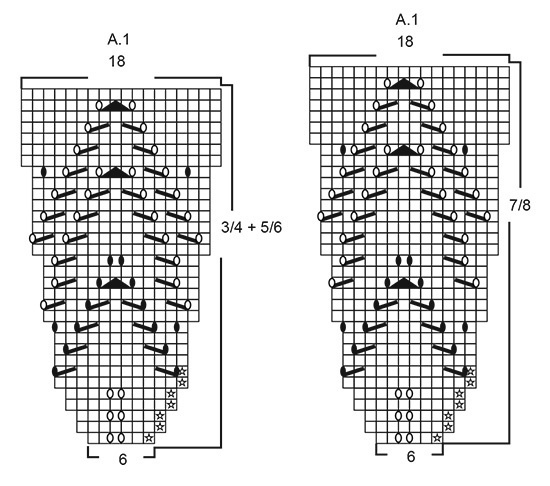
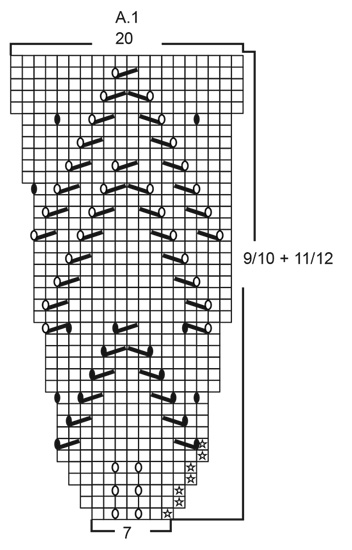
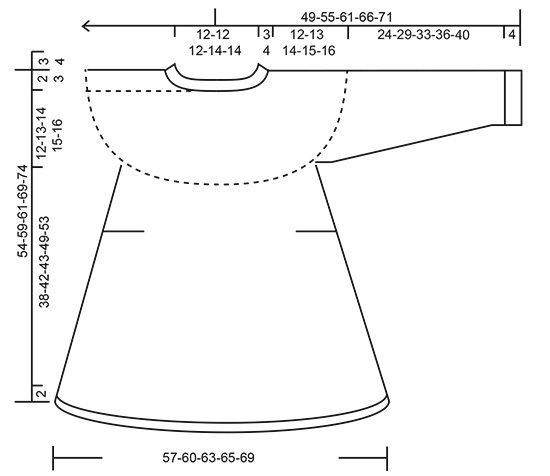
What can you do with our patterns? You can share DROPS patterns online, using the pattern original picture, materials, name and number. But you are NOT ALLOWED to reproduce the complete pattern digitally in any way. Yarn stores are welcome to use the DROPS pattern database to promote the sale of our assortment. You can print out our patterns, make as many copies as you’d like. The only thing we ask is that you don't make any changes / additions to the original printed document. And that the patterns according to the DROPS philosophy are given out to the consumers for free. Editorials that wish to publish our patterns in printed books or magazines can contact us for more information. The sale of garments based on DROPS patterns is permitted as long as they are sold as single items or per order. Further commercial use of the patterns is not permitted. It has to be clearly stated that the garment is made based on a design from DROPS DESIGN. The use of clothing labels of which DROPS DESIGN forms part is conditioned by the inclusion of the following text: “A DROPS DESIGN made by …..”. The use of DROPS photos for marketing purposes/sales is only permitted in connection with the use/sale of DROPS products. The photos may not be cut or edited and the logo should be clearly visible.
We reserve the right to withdraw the permission for use of our patterns at any time, notwithstanding the reason.
Each of our patterns has specific tutorial videos to help you.
These step-by-step tutorials might also help you:
Why is the knitting/crochet tension so important?
Knitting tension is what determines the final measurements of your work, and is usually measured per 10 x 10 cm. It is provided like so: number of stitches in width x number of rows in height - eg: 19 stitches x 26 rows = 10 x 10 cm.
The knitting tension is very individual; some people knit/crochet loosely while others work tightly. You adjust the knitting tension with the needle size, which is why the suggested needle size is only meant as a guide! You need to adjust this (up or down) to ensure that YOUR knitting tension matches the knitting tension provided in the pattern. If you work with a different knitting tension than provided you will have a different yarn consumption, and your work will have different measurements than what the pattern suggests.
The knitting tension also determines which yarns can replace each other. As long as you achieve the same knitting tension you can replace one yarn with another.
See DROPS lesson: How to measure your tension/gauge
See DROPS video: How to make a gauge tension swatch
How do I know how many balls of yarn I need?
The required amount of yarn is provided in grams, eg: 450 g. To calculate how many balls you’ll need you first need to know how many grams are in 1 ball (25g, 50g or 100g). This information is available if you click on the individual yarn quality on our pages. Divide the amount required with the amount of each ball. For example, if each ball is 50g (the most common amount), the calculation will be as follows: 450 / 50 = 9 balls.
Can I use a different yarn than what the pattern suggests?
The important thing when changing from one yarn to another is that the knitting/crochet tension remains the same. This is so that the measurements of the finished piece will be the same as on the sketch provided. It is easier to achieve the same knitting tension using yarns from the same yarn group. It is also possible to work with multiple strands of a thinner yarn to achieve the knitting tension of a thicker one. Please try our yarn converter. We recommend you to always work a test swatch.
Please NOTE: when changing yarn the garment might have a different look and feel to the garment in the photo, due to individual properties and qualities of each yarn.
See DROPS lesson: Can I use a different yarn than the one mentioned in the pattern?
What are the yarn groups?
All our yarns are categorised into yarn groups (from A to F) according to thickness and knitting tension – group A contains the thinnest yarns and group F the thickest. This makes it easier for you to find alternative yarns to our patterns, should you wish to switch yarn. All yarns within the same group have a similar knitting tension and can easily replace each other. However, different yarn qualities have different structures and properties which will give the finished work a unique look and feel.
How do I use the yarn calculator?
At the top of all our patterns you’ll find a link to our yarn calculator, which is a helpful tool should you wish to use a different yarn than suggested. By filling in the yarn quality you wish to replace, the amount (in your size) and number of strands, the calculator will present good alternative yarns with the same knitting tension. Additionally it will tell you how much you’ll require in the new qualities and whether you’ll need to work with multiple strands. Most skeins are 50g (some are 25g or 100g).
If the pattern is worked with multiple colours, every colour will have to be calculated separately. Similarly, if the pattern is worked with several strands of different yarns (for example 1 strand Alpaca and 1 strand Kid-Silk) you will have to find alternatives for each, individually.
Why do you show discontinued yarns in the patterns?
Since different yarns have different qualities and textures we have chosen to keep the original yarn in our patterns. However, you can easily find options among our available qualities by using our yarn calculator, or simply pick a yarn from the same yarn group.
It is possible that some retailers still have discontinued yarns in stock, or that someone has a few skeins at home that they would like to find patterns for.
The yarn calculator will provide both alternative yarn as well as required amount in the new quality.
What size should I knit?
If you think it's hard to decide what size to make, it can be a good idea to measure a garment you own already and like the size of. Then you can pick the size by comparing those measures with the ones available in the pattern's size chart.
You'll find the size chart at the bottom of the pattern.
See DROPS lesson: How to read size chart
Why do I get the wrong knitting tension with the suggested needle size?
The needle size provided in the pattern serves only as a guide, the important thing is to follow the knitting tension. And since knitting tension is very individual, you will have to adjust the needle size to ensure that YOUR tension is the same as in the pattern – maybe you’ll have to adjust 1, or even 2 needle sizes, up or down to achieve the correct tension. For this, we recommend that you work test swatches.
Should you work with a different knitting tension than the one provided, the measurements of the finished garment might deviate from the measurement sketch.
See DROPS lesson: How to measure your tension/gauge
See DROPS video: How to make a tension/gauge swatch
Why is the pattern worked top-down?
Working a garment top-down provides more flexibility and room for personal adjustment. For example it is easier to try the garment on while working, as well as making adjustments to length of yoke and shoulder caps.
The instructions are carefully explaining every step, in the correct order. Diagrams are adjusted to the knitting direction and are worked as usual.
How do I work according to a knitting diagram?
The diagram depicts all rows/rounds, and every stitch seen from the right side. It is read from bottom to top, from right to left. 1 square = 1 stitch.
When working back and forth, every other row is worked from the right side and every other row is worked from the wrong side. When working from the wrong side, the diagram will have to be worked reversed: from left to right, knit stitches are purled, purl stitches are knit etc.
When working in the round every round is worked from the right side and the diagram are worked from right to left on all rounds.
See DROPS lesson: How to read knitting diagrams
How do I work according to a crochet diagram?
The diagram depicts all rows/rounds, and every stitch seen from the right side. It is worked from bottom to top, from right to left.
When working back and forth every other row is worked from the right side: from right to left and every other row is worked from the wrong side: from left to right.
When working in the round, every row in the diagram are worked from the right side, from right to left.
When working a circular diagram you start in the middle and work your way outwards, counter clockwise, row by row.
The rows usually start with a given number of chain stitches (equivalent to the height of the following stitch), this will either be depicted in the diagram or explained in the pattern.
See DROPS lesson: How to read crochet diagrams
How do I work several diagrams simultaneously on the same row/round?
Instructions for working several diagrams after each other on the same row/round, will often be written like so: “work A.1, A.2, A.3 a total of 0-0-2-3-4 times". This means you work A.1 once, then A.2 is worked once, and A.3 is repeated (in width) the number of times provided for your size – in this case like so: S = 0 times, M = 0 times, L=2 times, XL= 3 times and XXL = 4 times.
The diagrams are worked as usual: begin with the first row in A.1, then work the first row in A.2 etc.
See DROPS lesson: How to read knitting diagrams
See DROPS lesson: How to read crochet diagrams
Why are the sleeves shorter in larger sizes?
The total width of the garment (from wrist-to-wrist) will be larger in the larger sizes, despite the actual sleeves being shorter. The larger sizes have longer sleeve caps and wider shoulders, so there will be a good fit in all sizes.
Where on the garment is the length measured?
The measurement sketch/schematic drawing provides information regarding the full length of the garment. If it’s a jumper or a jacket the length is measured from the highest point on the shoulder closest to the neckline, and straight down to the bottom of the garment. It is NOT measured from the tip of shoulder. Similarly, the length of yoke is measured from the highest point on the shoulder and down to where yoke is split into body and sleeves.
On a jacket measures are never taken along bands, unless specifically stated. Always measure inside band stitches when measuring the length.
See DROPS lesson: How to read a schematic drawing
What is a repeat?
Diagrams are often repeated on the round or in height. 1 repeat is the diagram the way it appears in the pattern. If it says to work 5 repeats of A.1 in the round, then you work A.1 a total of 5 times after/next to each other in the round. If it says to work 2 repeats of A.1 vertically/in height you work the entire diagram once, then begin again at the start and work the entire diagram one more time.
Why does the piece start with more chain stitches than it’s worked with?
Chain stitches are slightly narrower than other stitches and to avoid working the cast-on edge too tight, we simply chain more stitches to begin with. The stitch count will be adjusted on the following row to fit the pattern and measurement sketch.
Why increase before the rib edge when the piece is worked top-down?
The rib edge is more elastic and will contract slightly compared to, for example, stocking stitch. By increasing before the rib edge, you avoid a visible difference in width between the rib edge and the rest of the body.
Why increase in the cast-off edge?
It’s very easy to cast off too tightly, and by making yarn overs while casting off (and simultaneously casting these off) you avoid a too tight cast off edge.
See DROPS video: How to bind off with yarn overs (yo)
How do I increase/decrease on every 3rd and 4th row/round alternately?
To achieve an even increase (or decrease) you can increase on, for example: every 3rd and 4th row alternately, like so: work 2 rows and increase on the 3rd row, work 3 rows and increase on the 4th. Repeat this until the increase is complete.
See DROPS lesson: Increase or decrease 1 st on every 3rd and 4th row alternately
How can I work a jacket in the round instead of back and forth?
Should you prefer to work in the round instead of back and forth, you may of course adjust the pattern. You’ll need to add steeks mid-front (usually 5 stitches), and follow the instructions. When you would normally turn and work from the wrong side, simply work across the steek and continue in the round. At the end you’ll cut the piece open, pick up stitches to work bands, and cover the cut edges.
See DROPS video: How to knit steeks and cut open
Can I work a jumper back and forth instead of in the round?
Should you prefer to work back and forth instead of in the round, you may of course adjust the pattern so you work the pieces separately and then assemble them at the end. Divide the stitches for the body in 2, add 1 edge stitch in each side (for sewing) and work the front and back pieces separately.
See DROPS lesson: Can I adapt a pattern for circular needles into straight needles?
Why is the pattern slightly different than what I see in the photo?
Pattern repeats can vary slightly in the different sizes, in order to get the correct proportions. If you’re not working the exact same size as the garment in the photo, yours might deviate slightly. This has been carefully developed and adjusted so that the complete impression of the garment is the same in all sizes.
Make sure to follow instructions and diagrams for your size!
How do I make a women’s size garment into a men’s size one?
If you have found a pattern you like which is available in women’s size it’s not very difficult to convert it to men’s size. The biggest difference will be the length of sleeves and body. Start working on the women size that you think would fit across the chest. The additional length will be worked right before you cast off for the armhole/sleeve cap. If the pattern is worked top-down you can add the length right after the armhole or before the first decrease on sleeve.
Regarding additional yarn amount, this will depend on how much length you add, but it is better with a skein too many than too few.
How do I prevent a hairy garment from shedding?
All yarns will have excess fibres (from production) that might come off as lint or shedding. Brushed yarns (ie hairier yarns) have more of these loose, excess fibres, causing more shedding.
Shedding also depends on what is worn under or over the garment, and whether this pulls at the yarn fibres. It’s therefore not possible to guarantee that there will be no shedding
Below are some tips on how to get the best result when working with hairier yarns:
1. When the garment is finished (before you wash it) shake it vigorously so the looser hairs come off. NOTE: do NOT use a lint roller, brush or any method that pulls at the yarn.
2. Place the garment in a plastic bag and put it in your freezer - the temperature will cause the fibres to become less attached to each other, and excess fibres will come off easier.
3. Leave in the freezer for a few hours before taking it out and shaking it again.
4. Wash the garment according to the instructions on the yarn label.
Why does my garment pill?
Pilling is a natural process that happens to even the most exclusive of fibers. It's a natural sign of wear and tear that is hard to avoid, and that is most visible in high friction areas of your garment like a sweater's arms and cuffs.
You can make your garment look as new by removing the pilling, using a fabric comb or a pill/lint remover.
In the meantime, you can read the questions and answers that others have left to this pattern or join the DROPS Workshop on Facebook to get help from fellow knitters/crocheters!
You might also like...
Woodland Fairy
Woodland Fairy
Woodland Fairy
Woodland Fairy
Woodland Fairy |
||||||||||||||||||||||
 |
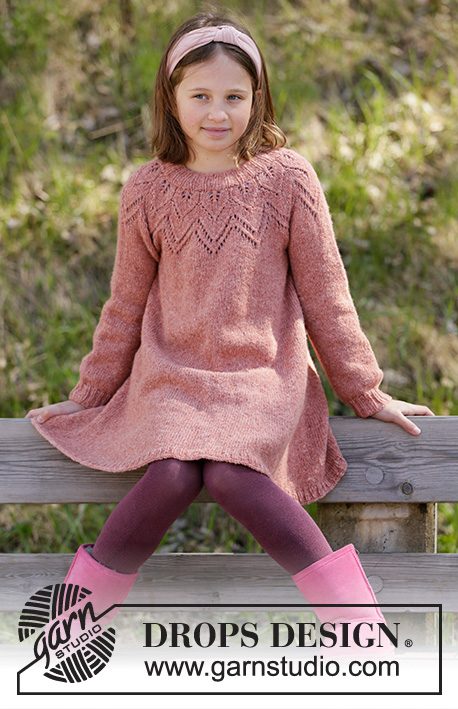 |
|||||||||||||||||||||
Knitted dress for children in DROPS Sky or DROPS Merino Extra Fine. The piece is worked top down with lace pattern. Sizes 3-12 years.
DROPS Children 34-25 |
||||||||||||||||||||||
|
------------------------------------------------------- EXPLANATIONS FOR THE PATTERN: ------------------------------------------------------- INCREASE TIP: Increase with 1 yarn over; on the next round work the yarn over twisted to avoid a hole. PATTERN: See diagram A.1; choose your size in the diagram. ------------------------------------------------------- START THE PIECE HERE: ------------------------------------------------------- DRESS: The yoke is worked in the round, top down. After the piece has been divided for body and sleeves, the body is continued in the round with circular needle, and the sleeves are workedin the round with double pointed needles. YOKE: Cast on 72-78-84-90-96 stitches with short circular needle size 3.5 mm and Sky. Insert 1 marker at the beginning of the round (= mid back). Work rib with knit 1/ purl 2 for 3-3-4-4-4 cm (= neck). The piece is now measured from here. Change to short circular needle size 4 mm and knit 2 rounds, adjusting on the first round the number of stitches to 66-72-78-84-91 stitches. Then work A.1 (= 11-12-13-12-13 repeats in width) – see diagram for the correct size! REMEMBER THE KNITTING TENSION! Change to a longer circular needle when you have increased enough stitches. When A.1 has been completed there are 198-216-234-240-260 stitches on the needle. On the next round increase 14-12-10-24-20 stitches evenly spaced while at the same time working stocking stitch = 212-228-244-264-280 stitches. Continue with stocking stitch until the piece measures 12-13-14-15-16 cm (without the rib). The next round is worked as follows: Knit 31-33-35-37-39 stitches (= half the back piece), place the next 44-48-52-58-62 stitches on 1 thread for sleeve (without working them), cast on 6 new stitches, knit 62-66-70-74-78 stitches (= front piece), place the next 44-48-52-58-62 stitches on 1 thread for sleeve (without working them), cast on 6 new stitches and knit 31-33-35-37-39 stitches (= half the back piece). BODY: = 136-144-152-160-168 stitches. THE PIECE IS NOW MEASURED FROM HERE! Now insert 6 markers in the piece as follows: Marker 1 is inserted in the first stitch at the beginning of the round (= side), marker 2 is inserted in the 23rd-25th-26th-27th-28th stitch, marker 3 is inserted in the 47th-49th-52nd-55th-58th stitch, marker 4 is inserted in the 69th-73rd-77th-81st-86th stitch (= side), marker 5 is inserted in the 91st-97th-102nd-107th-114th stitch, marker 6 is inserted in the 115th-121st-128th-135th-144th stitch (there are 21-23-24-25-24 stitches left on the round after the last marker). READ INCREASE TIP! On the next round increase 1 stitch on each side of each marker (12 stitches increased on round) and repeat these increases every 1½-2-2-2-1½ cm a total of 4 times. Then increase as follows: Increase 1 stitch on each side of markers 1 and 4 (= sides), 1 stitch after markers 2 and 5 and 1 stitch before markers 3 and 6 – READ INCREASE TIP (= 8 stitches increased per round). Increase in the different sizes as follows: 3/4 years: Increase approx every 3 cm a total of 11 times. 5/6 years: Increase approx. every 3 cm a total of 11 times. 7/8 years: Increase approx. every 3 cm a total of 12 times. 9/10 years: Increase approx. every 3½ cm a total of 12 times. 11/12 years: Increase approx. every 4 cm a total of 12 times. There are now 272-280-296-304-312 stitches on the round. Work until the piece measures 38-42-43-49-53 cm. On the next round increase 34-35-37-38-39 stitches evenly spaced – READ INCREASE TIP (increase after approx. each 8th stitch) = 306-315-333-342-351 stitches. Change to circular needle size 3.5 mm and work rib with knit 1/ purl 2 for 2 cm. Loosely cast off with knit on the next round. SLEEVE: Place the stitches from the one thread on double pointed needles size 4 mm and knit up 1 stitch in each of the 6 stitches cast on in the side of the body (insert 1 marker in the middle of these stitches) = 50-54-58-64-68 stitches. THE PIECE IS NOW MEASURED FROM HERE! Work stocking stitch in the round. When the piece measures 24-29-33-36-40 cm from the marker adjust the number of stitches to 42-42-48-48-48 stitches. Change to double pointed needles size 3.5 mm and work rib with knit 1/ purl 2 for 4 cm. Loosely cast off with knit on the next round. Work the other sleeve in the same way. |
||||||||||||||||||||||
Diagram explanations |
||||||||||||||||||||||
|
||||||||||||||||||||||

|
||||||||||||||||||||||

|
||||||||||||||||||||||

|
||||||||||||||||||||||
|
Have you made this or any other of our designs? Tag your pictures in social media with #dropsdesign so we can see them! Do you need help with this pattern?You'll find tutorial videos, a Comments/Questions area and more by visiting the pattern on garnstudio.com. © 1982-2024 DROPS Design A/S. We reserve all rights. This document, including all its sub-sections, has copyrights. Read more about what you can do with our patterns at the bottom of each pattern on our site. |
||||||||||||||||||||||
With over 40 years in knitting and crochet design, DROPS Design offers one of the most extensive collections of free patterns on the internet - translated to 17 languages. As of today we count 304 catalogues and 11422 patterns - 11422 of which are translated into English (UK/cm).
We work hard to bring you the best knitting and crochet have to offer, inspiration and advice as well as great quality yarns at incredible prices! Would you like to use our patterns for other than personal use? You can read what you are allowed to do in the Copyright text at the bottom of all our patterns. Happy crafting!







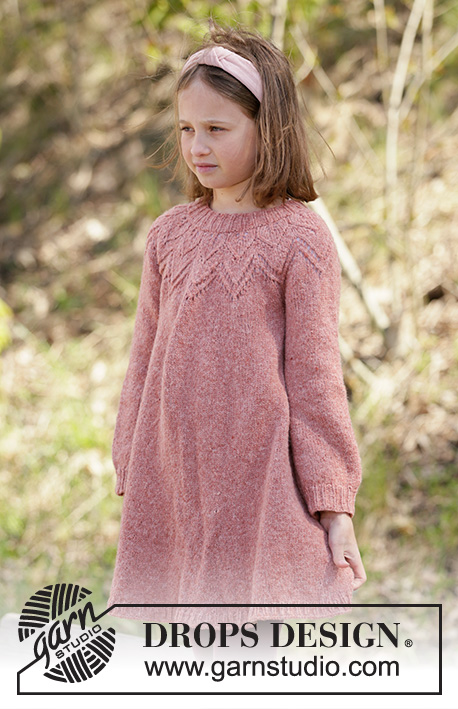

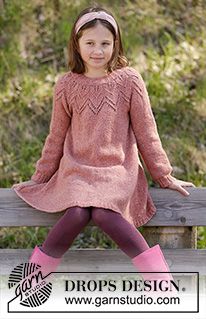
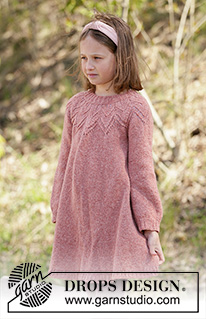











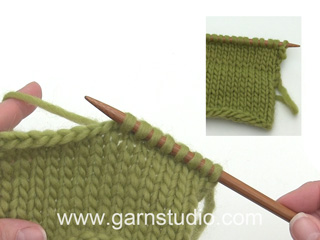



































Comments / Questions (50)
Hogy fér bele a gyermek feje, ha a nyakkivágás csak kb. 30 cm ? A 3,5-es kötőtűvel kezdve lesz annyira rugalmas a patent a nyakán, hogy egy 3 éves 50 cm fejkörfogatú lányka fel tudja venni ? Köszönöm válaszukat előre is!
04.06.2020 - 21:03DROPS Design answered:
Dear Zsuzsa, the rib is stretchy, so it should be ok. The problem may be with the first round (casting on). Try to do it as elastic as possible. You can use bigger needles to do it, or use two needles, please see our video HERE. Don't give up and happy knitting!
20.11.2020 - 08:47Hva betyr stjernen i starten av diagrammet?
23.05.2020 - 10:10DROPS Design answered:
Hei Emilie, Stjernen betyr at du skal strikke en vrangmaske. God fornøyelse!
25.05.2020 - 07:38Thanks for this pattern. In this pattern there are two types of YO, one to create a hole and the other to be twisted knit on the next row. Some rows have both. Would it be OK to increase by the knit front and back method where we don’t want a hole to be? Would make it easier.
08.05.2020 - 00:34DROPS Design answered:
Dear Jillyknits, if you don't want to increase with the yarn overs, you can also tray to increase with the M1 (make one) technique, this would avoid the small demarcation you would get with knitting front and back loop of a stitch. But feel free to test different increase techniques on a swatch and choose the one you rather. Happy knitting!
08.05.2020 - 09:16Hallo, kann es sein, dass die linken Maschen im Diagramm nicht versetzt, sondern immer übereinander gestrickt werden. Vielen Dank!
05.05.2020 - 23:07DROPS Design answered:
Liebe Hermine, ja genau, sie sind im Diagram wegen Zunahmen in der Mitte vom Diagram versetzt aber sie werden immer übereinander gestrickt. Viel Spaß beim stricken!
06.05.2020 - 10:32Jeg strikker str 11/12 og er nået tilsat sætte 6 markører . Når ærmerne er formet starter omgangen jo midt bag, men i opskriften står der at første markør er siden . Der er ikke nogen markør i siden men før og efter ærmet og midt for og midt bag. Er det forkert? Vh Iben
08.04.2020 - 09:11DROPS Design answered:
Hei Iben. De 6 merkene som settes i plagget, er der hvor du skal øke. 1. merke indikerer hvor du skal øke første gang. Det skal økes med 1 maske på hver side av hvert merke (12 masker økt pr økning), da vil det bli en jevn økning rundt hele kjolen. 1. og 4. merke viser også sidene i kjolen. God Fornøyelse!
27.04.2020 - 12:04Hei. Strikker denne kjolem og er nå på økningene under arm. I følge str 3-4 år skal det økes 4 ganger hver 1.5 cm og 11 ganger hver 3 cm. Dette blir jo 39 cm. Så står det at mam videre skal strikke til arbeidet måler 38 cm. Det stemmer ikke for meg når jeg allerede har 39 cm. Har jeg regnet feil?
30.03.2020 - 23:43DROPS Design answered:
Hej Den första ökningen blir när arbetet mäter 0 cm, den andra efter 1,5 cm osv så det innebär att arbetet är 4,5 cm efter de 4 första ökningarna och när alla ökningar är klara mäter arbetet ca 37,5 cm (4,5 + 33 ). Mvh DROPS Design
31.03.2020 - 07:11Mi hija acaba de cumplir 4 años esta bien realizar la prenda en talla de 3 a 4 años.....? por que la talla de 5 a 6 creo que sera muy grande para ella.
28.03.2020 - 19:36DROPS Design answered:
Hola Karla. Para elegir la talla correcta como referencia puedes usar las medidas de la prenda bajo el patrón. Cuando tengas dudas entre dos tallas recomendamos elegir la talla más grande.
29.03.2020 - 23:11Når jeg har taget 11 gange ud i størrelse 5/6 år, så får jeg 282 masker og ikke 280. De 282 passer også med regnestykket 144+50 (5x12)+88(11x8). Hvor regner jeg forkert? Mvh Christina
19.03.2020 - 22:53DROPS Design answered:
Hej Den första ökningen gör du totalt 4 gånger; 4 x 12 =48 m. 144+48+88= 280 m. Lycka till!
20.03.2020 - 06:57I have reached the point in this pattern where I have separated for sleeves and body. All good so far, but please can you explain why the first and fourth markers indicate (=side) instead of mid -front and mid-back? Are these the correct places for increasing? Thank you in advance!
09.03.2020 - 23:20DROPS Design answered:
Dear Nicky, you have to put the markers , and decrease and increase at the sides for waist shaping and shaping the skirt of the dress, which you don't do at the middle of the front and back BUt at the sides. I hope this helps. Happy Knitting!
10.03.2020 - 05:22Tack för svar! Jag var nog otydlig. Det är på varv 2 och 3 i diagrammet som det blir tokigt. Gör jag ingen förskjutning på första aviga så stämmer det, men blir fel på tredje...
05.03.2020 - 17:08DROPS Design answered:
Hej Marie Är inte helt säker på att jag förstår vad du menar, men den första aviga i diagrammet gör du alltid på den första maskan på varvet, då ska mönstret stämma. Hålmönstret ska komma i linje uppåt. Mvh DROPS Design
06.03.2020 - 13:30